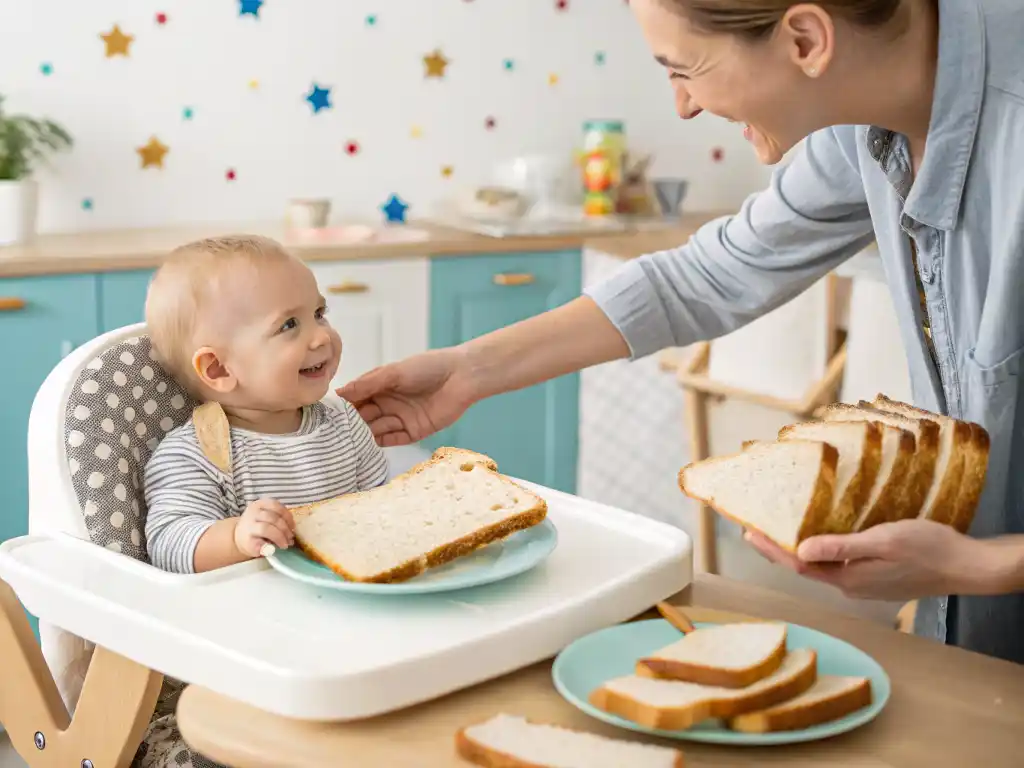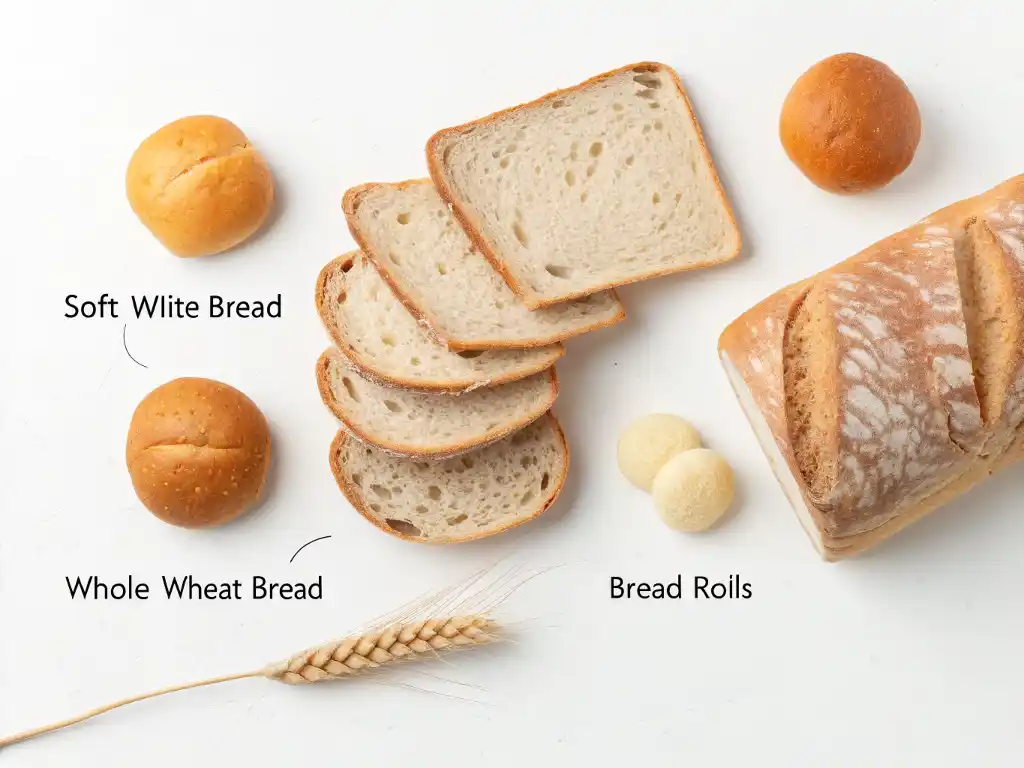Respond this question: How do you serve sliced bread to a baby?Adding sliced bread to your baby’s diet is a big step. It brings new tastes and textures for them to enjoy. But, it’s important to be careful to keep your baby safe. This guide will help you serve sliced bread safely to your baby. We’ll cover the good stuff it offers, when to start, and how to serve it without worrying about choking.
A soft, colorful baby plate filled with small, bite-sized pieces of lightly toasted sliced bread, surrounded by fresh, vibrant fruit slices such as bananas and strawberries, with a gentle pastel background, and a playful atmosphere.
Table of Contents
Key Takeaways
- Sliced bread can be a nutritious addition to a baby’s diet, providing essential vitamins and minerals.
- The right age to introduce sliced bread varies, but it’s generally safe to start around 6-8 months of age.
- Proper preparation and serving techniques, such as toasting and cutting into appropriate shapes, can help prevent choking hazards.
- Selecting the right types of bread, such as whole grain options, can ensure your baby receives the optimal nutritional benefits.
- Monitoring your baby closely during mealtimes and being aware of common choking risks are crucial for safe consumption of sliced bread.
Why Introducing Bread to Your Baby’s Diet Matters

As your little one starts their food journey, adding bread is a big step. Bread is a key food in many cultures. It’s full of nutrients that help your baby grow and learn to eat solid foods.
Nutritional Benefits of Bread for Infants
Whole-grain bread is packed with vitamins, minerals, and fiber. These are important for your baby’s health. Whole-grain bread is better than white bread because it has more nutrients. It helps your baby start with a healthy diet.
Incorporating nutritious bread options into your baby’s diet ensures they get essential vitamins and minerals. If you’re interested in experimenting with simple bread recipes, learn how to make bread and egg here.
When to Start Offering Bread
It’s best to introduce bread to your baby between 6 to 12 months. This is when they start eating solid foods. Always talk to your pediatrician to see when it’s right for your baby.
Understanding Bread’s Role in Baby-Led Weaning
Bread is great for baby-led weaning. Give your baby small, soft pieces of bread. This lets them learn about different tastes and textures. It also helps them become independent and develop important skills.
“Introducing bread to your baby’s diet can be a delightful and nourishing experience, paving the way for a lifetime of healthy eating habits.”
How do you serve sliced bread to a baby?
Introducing sliced bread to your baby’s diet can be fun and healthy. But, it’s key to follow safety rules. You want to give your baby the good stuff from bread without any choking hazards. Let’s look at how to serve sliced bread safely and well.
Proper Cutting Techniques
When cutting bread for your baby, make sure it’s in small, easy-to-eat pieces. Don’t cut it into long, thin strips that could be a choking risk. Go for square or rectangular pieces that are about 1-inch big. This size is perfect for your baby to hold and chew without the risk of accidental swallowing.
Appropriate Serving Sizes
Begin with small amounts of bread, like 1-2 pieces per meal. This lets your baby get used to the taste and texture without feeling full. As they get more comfortable with bread, you can give them a bit more.
Reducing Choking Hazards
- Always watch your baby while they eat to make sure they’re chewing and swallowing safely.
- Teach your baby to take small bites and chew well before swallowing.
- Don’t give bread with hard crusts or thick textures that are hard for your baby to handle.
| Technique | Benefits |
|---|---|
| Cutting bread into small, manageable pieces | Reduces choking hazards and makes it easier for your baby to grasp and consume |
| Starting with small serving sizes | Allows your baby to explore the new texture and flavor without overwhelming their digestive system |
| Supervising your baby during mealtime | Ensures your baby is chewing and swallowing the bread safely |
By following these tips, you can safely serve sliced bread to your baby. This nutritious food can be a great addition to their diet.
Best Types of Bread for Babies

Choosing the right bread for your baby can be tough. You have many options, from whole grain to allergen-free. Knowing what to look for helps you pick the best bread for your baby’s health.
Whole Grain vs. White Bread Options
Whole grain breads are great for babies. They have more fiber, vitamins, and minerals than white bread. These options, like baby-friendly bread and whole grain for infants, help with digestion and growth.
Avoiding High-Sodium and Sugary Breads
Stay away from breads high in sodium or sugar. Opt for low-sodium bread with little sodium and sugar. Too much of these can harm your baby’s health.
Allergen Considerations When Selecting Bread
If your baby has food allergies, check the bread’s ingredients. Choose allergen-free bread without common allergens. This ensures a safe and fun mealtime for your baby.
| Bread Type | Nutritional Benefits | Potential Concerns |
|---|---|---|
| Whole Grain | Higher in fiber, vitamins, and mineralsSupports healthy digestionPromotes overall growth and development | Texture may be harder for some babies to chew |
| White Bread | Softer textureEasier for some babies to chew | Lower in fiber, vitamins, and mineralsMay not provide as many nutritional benefits |
| Low-Sodium | Reduces risk of excess sodium intakeSupports healthy blood pressure and kidney function | May have a slightly different taste or texture |
| Allergen-Free | Safe for babies with food allergiesProvides a wider range of options for parents | May be more expensive or harder to find |
“When introducing bread to your baby, it’s important to choose options that are nutritious, safe, and tailored to their developmental needs.”
Proper Size and Shape for Safe Consumption
When you start giving sliced bread to your baby, think about the right size and shape. This is key to avoid choking hazards. The right food sizes and shapes help keep your baby safe during meals.
Bite-Sized Pieces for Easy Chewing
Cut bread into small pieces for safe eating. Go for cubes or strips that are no bigger than 1/2 inch. This size is less likely to cause choking.
These sizes let your baby pick up, chew, and swallow bread easily. It makes mealtime safer and more enjoyable.
Soft, Manageable Shapes
The shape of the bread matters too. Soft, moist bread is better than dry, crumbly slices. Soft bread is easier for your baby to gum and swallow.
Avoid Long, Stringy Pieces
Don’t give your baby long, stringy bread. It’s hard for them to handle and can be a choking risk. Instead, give them short, manageable strips or cubed shapes.
| Safe Food Shapes for Infants | Unsafe Food Shapes for Infants |
|---|---|
| Soft, bite-sized cubesShort, manageable stripsMoist, squishable textures | Long, stringy piecesDry, crumbly slicesLarge, bulky portions |
By choosing the right size and shape of bread, you can prevent choking. This makes mealtime safe and fun for your baby.
“An assortment of sliced bread shapes suitable for infants, including small squares, triangles, and rounded pieces, all arranged on a bright, colorful plate. Emphasize safe sizes and textures, with soft crusts and fluffy interiors, set against a cheerful kitchen backdrop.”
“The right size and texture of bread can make all the difference in your baby’s ability to eat it safely and comfortably.”
Toast vs. Soft Bread: Making the Right Choice
Introducing bread to your baby’s diet is a big step. The bread’s texture is key for safe and fun meals. Both toasted and soft bread have their perks, but knowing the differences is crucial.
Benefits of Toasting Bread for Babies
Toasting bread makes it firmer and easier for babies to chew. It also lowers the risk of choking. Toasted bread is less likely to turn into a sticky mess in a baby’s mouth.
Texture Modifications for Different Ages
Babies grow and their ability to handle bread changes. Newborns and young babies prefer soft bread. As they get older, around 6-8 months, you can start with lightly toasted bread.
As they get better at chewing, you can toast the bread a bit more. This way, you can adjust the texture to match their growing skills.
| Age Range | Recommended Bread Texture |
|---|---|
| 0-6 months | Soft, finely-textured bread |
| 6-8 months | Lightly toasted bread |
| 8 months and up | Moderately toasted bread |
Knowing the benefits of toasted bread and how to adjust it for your baby’s age is key. This way, you can introduce bread safely and make mealtime fun.
Common Choking Hazards to Avoid
When serving bread to your baby, watch out for choking hazards. Babies and young kids are more at risk because their airways are small. They’re still learning how to chew and swallow. So, remember these baby food safety and choking prevention tips when introducing bread.
- Avoid bread with hard crusts or tough textures that could get stuck in your baby’s throat.
- Don’t give large, uncut bread pieces as they can be a big infant feeding precautions choking risk.
- Stay away from dry, crumbly bread that can easily break apart and become a choking hazard.
- Don’t serve bread with nuts, seeds, or other small, hard ingredients that could block your baby’s airway.
Always put your baby’s safety first when introducing new foods. By following these choking prevention tips, you can make bread-feeding a positive experience for your baby.
“Keeping a watchful eye on your baby during mealtime is essential for their safety and your peace of mind.”
By following these baby food safety guidelines and staying alert, you can safely add bread to your baby’s diet. With caution and care, you can help your baby enjoy the world of bread.
Creative and Safe Bread Preparations
When it comes to serving bread to your baby, it’s more than just picking the right bread. It’s about making mealtime fun and engaging. You can try different spreads, shapes, and designs to make bread a delightful treat.
Healthy Spread Options
Don’t use sugary jams or processed spreads. Instead, try homemade nut or seed butters like almond or pumpkin seed butter. They’re full of good fats and protein. You can also use mashed avocado, hummus, or cottage cheese for a creamy, nutritious spread.
Fun Shapes and Presentations
Be creative with your bread shapes. Use cookie cutters for stars, hearts, or circles. Or, cut the bread into thin strips or small cubes for self-feeding. Add colorful toppings like sliced fruit or grated vegetables to make meals fun and appealing.
Focus on nutritious ingredients and fun presentations for safe, enjoyable bread experiences. These creative ideas help nourish your child and encourage a positive food relationship.
Signs Your Baby is Ready for Sliced Bread
Introducing sliced bread to your baby’s diet is a big step. It’s important to know when your baby is ready. Look for signs that show they can safely eat this food.
One key sign is if your baby can sit up without help. This usually happens around 6 months. It helps them eat safely. Also, being able to pick up small things with their thumb and forefinger is a big milestone. It shows they’re ready to feed themselves with sliced bread.
- Sits upright without support
- Develops a strong pincer grasp
- Shows interest in and reaches for food
- Begins to chew and move food around in their mouth
- Demonstrates the ability to swallow solid foods
As your baby grows, they’ll get more interested in solid foods. They’ll want to try new things. Watch for these signs and introduce sliced bread when they’re ready.
| Milestone | Age Range |
|---|---|
| Sits upright without support | Around 6 months |
| Develops a strong pincer grasp | Around 6-8 months |
| Starts to chew and swallow solid foods | Around 6-9 months |
Watching your baby grow helps you know when to introduce sliced bread. It’s a fun way to start new foods and help them grow strong.
A cozy kitchen scene featuring a high chair with a baby exploring a plate of sliced bread, various developmental toys scattered around, a soft sunlight filtering through a window, colorful baby-sized utensils nearby, and subtle signs of curiosity and engagement on the baby’s face, emphasizing readiness for solid foods.
Monitoring Your Baby While Eating Bread
When your baby starts eating sliced bread, keep a close eye on them. It’s important to watch them eat to make sure they’re safe. This way, you can avoid choking hazards and help them enjoy eating bread.

Watch how your baby holds, chews, and swallows the bread. If they start coughing, gagging, or having trouble breathing, act fast. Babies are still learning how to handle food, so it’s crucial to watch them closely.
Also, be calm and supportive while they eat. Talk to your baby, let them explore the bread, and teach them how to chew and swallow. This helps them feel comfortable and builds a good relationship with solid foods.
FAQ
What are the nutritional benefits of bread for infants?
Bread is good for babies. It has carbs, fiber, and vitamins and minerals. These help with growth and health.
When is the appropriate age to start offering bread to my baby?
Start bread around 6 months, when your baby is ready. They should be able to sit up and have good head control.
How does bread fit into a baby-led weaning approach?
Bread is great for baby-led weaning. It lets babies try new textures and learn to feed themselves.
What are the best types of bread to serve to a baby?
Choose whole grain bread for more fiber and nutrients. Avoid salty and sugary breads and watch for allergens.
What is the proper size and shape for serving bread to a baby?
Cut bread into small pieces to avoid choking. Use simple shapes like strips or cubes for easy handling.
Is toasted bread a better option for babies than soft bread?
Toasted bread is firmer, which is better for babies. But watch the texture to make sure it’s right for your baby’s age.
What are some common choking hazards to avoid when serving bread to babies?
Cut bread into small pieces and avoid hard crusts. Always watch your baby while they eat to prevent choking.
How can I creatively and safely prepare bread for my baby?
Use healthy spreads like mashed avocado or nut butter. Try fun shapes and presentations to make mealtime exciting.
What are the signs that my baby is ready to start eating sliced bread?
Look for signs like good head control and sitting up. Also, see if they want to touch and taste different foods.
How can I ensure my baby’s safety while they are eating bread?
Always watch your baby while they eat. Cut bread into small pieces and be ready to help if they choke.


1 thought on “How do you serve sliced bread to a baby? Three Safe Ways”